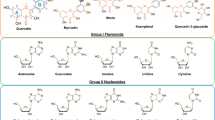Abstract
THE correlation between structure and biological action of the vitamin K group is an object of many investigations. However, in spite of much experimental material we still lack a satisfactory explanation of both the established correlations and of the mechanism of biological action of the natural vitamins K1 and K2 and of their synthetic analogues. It was, already in 1939 that L. F. Fieser first suggested tlie hypothesis1 further developed in 19412 that the biological activity of most analogues of vitamin K is due not to these substances as such, but to the quinones of the type of the natural vitamin into which they are transformed within the organism as a result of biological synthesis. As to the mechanism of biological action of the vitamin itself, this question remains open. L. F. Fieser's hypothesis is far from being in accord with much experimental evidence, nor does it offer a satisfactory explanation of much of it. At the same time it strikingly contradicts the notion that a perceptible, although slight, antihæmorrhagic activity is shown by phthalic acid3. This discrepancy is particularly noteworthy in view of the fact established in this laboratory that a high antihæmorrhagic activity is characteristic of the diethyl ether of phthalic acid (the biological assay was carried out by B. A. Kudriashev). The possibility of transformation, within the organism, of phthalic acid into compounds of the 1,4-naphthoquinone series is indeed extremely doubtful.
This is a preview of subscription content, access via your institution
Access options
Subscribe to this journal
Receive 51 print issues and online access
$199.00 per year
only $3.90 per issue
Buy this article
- Purchase on Springer Link
- Instant access to full article PDF
Prices may be subject to local taxes which are calculated during checkout
Similar content being viewed by others
References
Fieser, L. F., J. Amer. Chem. Soc., 61, 3467 (1939).
Fieser, L. F., Tischler, M., and Sampson, W. Z., J. Biol. Chem., 137, 659 (1941).
Packendorf, K. G., Kudriashev, B. A., and Lazareva, E. N., Doklady Acad. Nauk USSR., 31, 484 (1941) (Russ.).
Author information
Authors and Affiliations
Rights and permissions
About this article
Cite this article
SHEMIAKIN, M., SCHUKINA, L. & SHVEZOV, J. Mechanism of Biological Action of Vitamin K and its Synthetic Analogues. Nature 151, 585–586 (1943). https://doi.org/10.1038/151585b0
Issue Date:
DOI: https://doi.org/10.1038/151585b0
This article is cited by
-
Chemotherapy of tuberculosis
Proceedings of the Indian Academy of Sciences - Section A (1950)
-
Experimental Corroboration of the Mechanism of Biological Action of Quinones of the Type of Vitamin K
Nature (1944)
-
Alleged Vitamin K Activity of Phthalic Acid
Nature (1943)
Comments
By submitting a comment you agree to abide by our Terms and Community Guidelines. If you find something abusive or that does not comply with our terms or guidelines please flag it as inappropriate.



